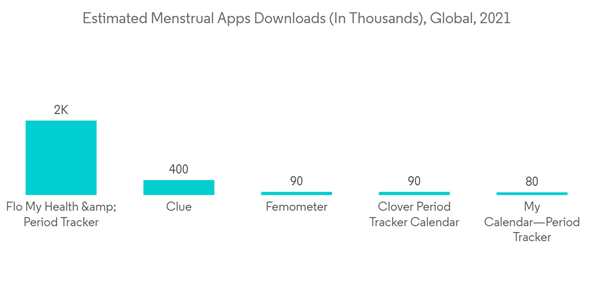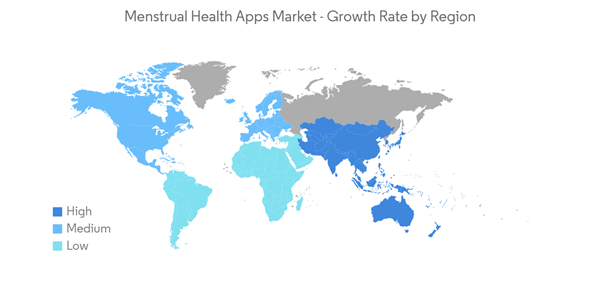The COVID-19 pandemic had a positive impact on the market. Menstrual health apps witnessed significant spikes in the adoption rate and recorded a dramatic rise in the number of users. Female communities across the globe were using femtech applications to maintain a healthy lifestyle and well-being. For example, the NCBI published a study in 2021 that looked at the impact of COVID-19 on menstrual cycle distress and the use and adoption of mobile apps by women during the pandemic.As per the results, around 77.9% of respondents reported using menstrual health-related mobile apps during the pandemic. This signifies that digital health technologies for women gained traction during the pandemic.
In addition, established players are developing their apps in multiple languages to expand their clientele across the globe. For instance, Flo Health Inc. launched Flo, a menstrual and pregnancy tracking app, in 22 languages. The app allows users to track pregnancies and monitor fetal development and offers personalized daily informational content. Furthermore, Flo reported that around 35 million users were using its app monthly in 2020, with a total of 150 million installations.
Rising consciousness about menstrual health among women, the rise in digital literacies and smartphone adoption, increased internet accessibility, and the incidence of growing awareness of menstrual health hygiene are the factors driving the growth of the menstrual health apps market over the forecast period.
The rise in digital literacies and smartphone adoption is also propelling the growth of the market; for instance, in 2021, the International Telecommunication Union showed that uptake of the internet has accelerated during the pandemic. In 2019, 4.1 billion people (54 percent of the world’s population) were using the internet. Since then, the number of users has surged by 800 million to reach 4.9 billion people in 2021 (63 percent of the population).
In addition, new menstrual app launches and strategic activities by major players in the market are positively affecting the growth of the studied market. For instance, in December 2020, the LAIQA brand launched an app called Period Pal. This app can chart their menstrual cycles, as well as their energy levels, symptoms, and ovulation cycle predictions.
Furthermore, the growing focus of companies on developing advanced services and adopting various business strategies, such as collaborations and acquisitions, to maintain their market position is also contributing to market growth. For instance, in May 2022, Fertility Company Aprecicity acquired Period Tracking and Community Support App Woom, a women’s health app offering period tracking and community support for those trying to conceive. Therefore, owing to the aforementioned factors, it is anticipated that the studied market will witness growth over the analysis period.
Key Market Trends
The Menstrual Health Management Segment is Expected to Witness Growth Over the Forecast Period
The menstrual health management segment is expected to witness significant growth in the menstrual health apps market over the forecast period owing to factors such as rising awareness of menstrual health, strategic initiatives by key market players, and technological advancement in menstrual health apps.The rising awareness of menstrual health is the key factor driving the demand for menstrual health management. For instance, in July 2022, the National Library of Medicine published an article on menstrual hygiene management knowledge, practice, and associated factors among schoolgirls that showed approximately 66% of respondents had an adequate understanding of and experience managing menstrual hygiene.
Growing awareness about women’s health and initiatives to actively address it through digital technologies are driving segmental growth. For instance, UNICEF developed the app Okay for girls that will provide information about periods to young girls and also include an individualized cycle tracker. Government agencies are continuously working on spreading awareness related to women’s health, promoting advancements in mobile technologies, introducing favorable policies, supporting startups, and improving network connectivity. Such support is expected to drive the vertical in the near future.
The developer and manufacturer of smart wearables and mobile application developers are integrating their innovative product development strategies to efficiently cater to the requirements of women’s health management. Through such devices and applications, the female population can easily track their health condition, receive information related to their queries, and engage with healthcare professionals and female communities. For instance, the new Apple Watch Series 8 comes with a pair of temperature sensors that can detect changes in the body temperature to track illness and the menstrual cycle. The watch comes with built-in menstrual cycle tracking apps. Their upcoming watches, OS 9 and iOS 16, will also consist of a cycle-tracking app that will be able to detect abnormalities in the user’s cycle depending on the data the user has fed in. Therefore, the Menstrual Health Management segment is expected to witness significant growth over the forecast period due to the abovementioned factors.
North America is Expected to Dominate the Menstrual Health Apps Market During the Forecast period.
North America is expected to dominate the menstrual health apps market over the forecast period owing to factors such as increasing research and development activities, the significant presence of key players, the adoption of various strategies initiated by key companies to increase mobile phone penetration, rising demand for period cycle tracking apps, and new product launches.Furthermore, rising women's awareness of menstrual issues is a factor driving market growth over the forecast period.For instance, according to the widespread impact of period poverty on the United States, students surveyed in 2021 stated that 77% of them felt there needed to be more in-depth education about menstrual health, and 73% agreed that education around menstrual health should be part of the core curriculum. There should be free menstrual products, and 65% agree that society teaches people to be ashamed of their periods. Such a study implies that there is a high need for menstrual health awareness and supportive initiatives, which is likely to open growth horizons for the regional market over the forecast period.
Additionally, increasing research and development activities in menstrual health apps and health technologies in the region is likely to boost market growth. For instance, in March 2022, Sasha Cayward launched a new menstrual health app that not only tracks a user’s period and symptoms but also uses AI technology to provide personalized nutritional, fitness, and task management advice to improve the user’s daily life. Therefore, owing to the aforesaid factors, the growth of the studied market is anticipated in the North American region.
Competitive Landscape
The market for menstrual health apps is emerging and consolidating. Leading players deploy numerous strategic initiatives that include competitive pricing strategies, partnerships, product expansion, sales and marketing initiatives, and mergers and acquisitions. Some of the key players in the market are Flo Health, Eve by Glow, Glow Inc., BioWink GmbH, Planned Parenthood, Ovia Health, Period Tracker, Magic Girl, Perigee, and Apple Inc., among others.Additional benefits of purchasing the report:
- The market estimate (ME) sheet in Excel format
- 3 months of analyst support
This product will be delivered within 2 business days.
Table of Contents
Companies Mentioned (Partial List)
A selection of companies mentioned in this report includes, but is not limited to:
- Flo Health
- Eve by Glow
- Glow Inc
- Biowink GmbH
- Planned Parenthood
- Ovia Health
- Period Tracker
- MagicGirl
- Perigee
- Apple Inc.










